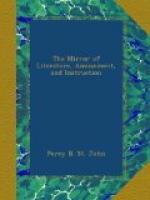Eastward, moon’s front beginneth first to lack,
Westward, sun’s brows begin their mourning black:
Moon’s eclipses come when she most glorious shines,
Sun’s in moon’s wane, when beauty most declines;
Moon’s general, towards heaven and earth together,
Sun’s but to earth, nor to all places neither.”
The Sun enters Sagittarius on the 23rd, at 1 h. 2 m. morning.
Mercury will be visible on the 10th, in 10 deg. of Sagittarius, a little after sunset, being then at his greatest eastern elongation; he is stationary on the 20th, and passes his inferior conjunction on the 30th, at 1-3/4 h. afternoon.
Venus is in conjunction with the above planet on the 24th, at 9 h. evening; she sets on the 1st at 5 h. 7 m., and on the 30th at 4 h. 47 m. evening.
Jupiter may be seen before sunrise making his appearance above the horizon about 5 h.; he is not yet distant enough from the sun to render the eclipses of his satellites visible to us.
A small comet has just been discovered, situated in one of the feet of Cassiopea. It is invisible to the naked eye, and appears approaching the pole with great rapidity.
PASCHE.
* * * * *
RETROSPECTIVE GLEANINGS.
* * * * *
DOMESTIC ECONOMY OF THE ROMANS IN THE FOURTH CENTURY.
A recent discovery has added to our information the most extensive series of statistical data, which make known from an official act, and by numerical figures, the state of the Roman empire 1500 years ago; the price of agricultural and ordinary labour; the relative value of money; the abundance or scarcity of certain natural productions; the use, more or less common, of particular sorts of food; the multiplication of cattle and of flocks; the progress of horticulture; the abundance of vineyards of various qualities; the common use of singular meats, and dishes, which we think betrays a corruption of taste; in short the relation of the value existing between the productions of agriculture and those of industry, from whence we obtain a proof of the degree of prosperity which both had reached at this remote period.
This precious archaeological monument is an edict of Diocletian, published in the year 303 of our era, and fixing the price of labour and of food in the Roman empire. The first part of this edict was found by Mr. William Hanks, written upon a table of stone, which he discovered at Stratonice, now called Eskihissar in Asia Minor. The second part, which was in the possession of a traveller lately returned from the Levant, has been, brought from Rome to London by M. de Vescovali, and Colonel Leake intends to publish a literal translation of it. This agreement of so many persons of respectable character, and known talents, excludes all doubts respecting the authenticity of the monument.




